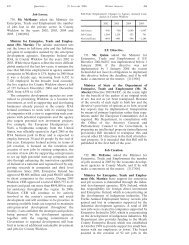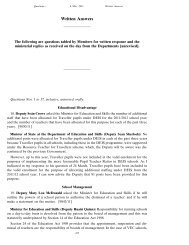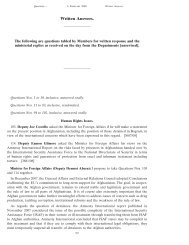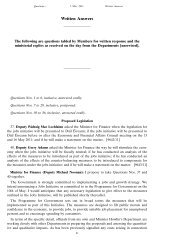[Deputy Phil Hogan.] Questions— 14 February 2012. <strong>Written</strong> <strong>Answers</strong> Local Action Group Programme Administration Administration Project Spend to Allocation: Allocation: 20% Spend to date date Project and overall allocation Administration Galway Rural Development €15,257,985 €3,051,597 €971,795.38 €2,910,798.66 Company Limited Inishowen Development €8,286,143 €1,657,229 €625,581.28 €1,794,576.78 Partnership I.R.D. Duhallow €10,315,943 €2,063,189 €721,022.77 €2,403,767.60 Kildare (Cill Dara ar Aghaidh €12,282,448 €2,456,490 €868,870.54 €1,202,802.20 Teoranta) County Kilkenny LEADER €11,523,729 €2,304,746 €833,182.31 €2,657,057.21 Partnership Limited Laois Community and Enterprise €10,993,608 €2,198,722 €879,759.20 €1,726,360.26 Development Leitrim Integrated Development €10,845,497 €2,169,099 €863,729.22 €1,799,413.10 Company Longford Community Resources €8,714,110 €1,742,822 €529,574.09 €1,720,286.30 Limited Louth LEADER Partnership €8,839,815 €1,767,963 €812,265.71 €1,642,010.67 Mayo North East LEADER €10,751,894 €2,150,379 €820,226.54 €2,090,088.07 Partnership Meath Partnership €12,748,771 €2,549,754 €1,105,071.84 €2,093,828.37 Mei<strong>the</strong>al Forbartha na Gaeltachta €17,278,809 €3,455,762 €1,314,883.67 €2,003,508.11 Teoranta North and East Kerry LEADER €10,558,882 €2,111,776 €849,954.60 €882,538.81 Partnership Teoranta North Tipperary LEADER €9,708,008 €1,941,602 €744,731.38 €2,694,542.57 Partnership Company Offaly Integrated Local €11,520,489 €2,304,098 €693,821.89 €2,419,636.12 Development Company Roscommon Integrated €12,838,021 €2,567,604 €832,371.17 €2,286,223.28 Development Company County Sligo LEADER €10,888,673 €2,177,735 €659,871.45 €3,344,222.85 Partnership Company South East Cork Area €10,641,494 €2,128,299 €675,991.95 €2,344,385.99 Development Limited South Kerry Development €12,370,667 €2,474,133 €1,128,984.93 €1,604,772.27 Partnership Limited South Tipperary Local €11,106,187 €2,221,237 €848,247.34 €2,286,527.10 Development Company Limited South West Mayo Development €12,150,007 €2,430,001 €766,966.56 €3,093,228.74 Company Limited Waterford LEADER Partnership €10,558,519 €2,111,704 €846,348.29 €2,344,291.88 Limited West Cork Development €14,601,149 €2,920,230 €1,047,709.16 €2,676,558.38 Partnership West Limerick Resources €9,997,751 €1,999,550 €822,146.32 €1,393,937.49 Westmeath Community €10,987,060 €2,197,412 €607,057.85 €1,207,408.38 Development Wexford Local Development €12,515,565 €2,503,113 €850,704.22 €2,993,987.78 County Wicklow Partnership €11,135,560 €2,227,112 €787,274.14 €1,651,520.00 Total €399,999,998 €80,000,000 €29,475,428 €74,952,481 506
Questions— 14 February 2012. <strong>Written</strong> <strong>Answers</strong> Telecommunications Services 411. Deputy Pat Deering asked <strong>the</strong> Minister for <strong>the</strong> Environment, Community and Local Government when <strong>the</strong> guidelines for telecommunications antennae and support structures were last updated; his plans to update same in <strong>the</strong> near future; if his attention has been drawn to <strong>the</strong> fact that o<strong>the</strong>r EU countries have different guidelines in this area; and if he is fully satisfied that public health is not at risk due to <strong>the</strong>se telecommunication structures. [7554/12] Minister <strong>of</strong> State at <strong>the</strong> Department <strong>of</strong> <strong>the</strong> Environment, Community and Local Government (Deputy Jan O’Sullivan): My Department published Guidelines for Planning Authorities on Telecommunications Antennae and Support Structures in 1996. The guidelines are intended to facilitate planning authorities, An Bord Pleanála, <strong>the</strong> licensed providers <strong>of</strong> mobile telecommunications services and <strong>the</strong> public by providing guidance on dealing with <strong>the</strong>se developments within <strong>the</strong> planning system. The guidelines set out a locational hierarchy in relation to <strong>the</strong> siting <strong>of</strong> radio masts and advise that free-standing masts should only be located within, or in <strong>the</strong> immediate surrounds <strong>of</strong>, smaller towns or villages as a last resort. If such a location should become necessary, masts and antennae should be designed and adapted for <strong>the</strong> specific location. In <strong>the</strong> vicinity <strong>of</strong> larger towns and in city suburbs, operators should endeavour to locate in industrial estates or in industrially zoned land. The guidelines fur<strong>the</strong>r advise that only as a last resort, and if all <strong>the</strong> alternatives are unavailable or unsuitable, should free-standing masts be located in a residential area or beside schools. Under Section 28 <strong>of</strong> <strong>the</strong> Planning and Development Act 2000, planning authorities are required to have regard to any Ministerial guidelines in <strong>the</strong> performance <strong>of</strong> <strong>the</strong>ir functions. The Guidelines are available on my Department’s website at www.environ.ie. The Guidelines will be kept under review in light <strong>of</strong> best scientific evidence and technical advice. My Department is not aware <strong>of</strong> <strong>the</strong> differences between Ireland and o<strong>the</strong>r EU countries’ guidelines in this area. The issue <strong>of</strong> <strong>the</strong> potential health effects <strong>of</strong> mobile phone masts was <strong>the</strong> subject <strong>of</strong> an Expert Group Report commissioned by <strong>the</strong> Government and published in March 2007. This Report, entitled Health Effects <strong>of</strong> Electromagnetic Fields, is available for download on my Department’s website (www.environ.ie). The Expert Group reported that <strong>the</strong> majority scientific opinion to date is that no adverse short or long term effects have been demonstrated from exposure to electromagnetic fields at levels below <strong>the</strong> limits recommended by <strong>the</strong> International Commission on Non-Ionising Radiation Protection (ICNIRP). However, extensive international research on <strong>the</strong> issue continues to be coordinated through bodies such as <strong>the</strong> World Health Organisation. The Commission for Communications Regulation (ComReg), <strong>the</strong> licensing authority for <strong>the</strong> telecommunications industry, commissions audit reports to verify that its licensed operators are in compliance with <strong>the</strong>ir licence conditions relating to emission limits for non-ionising radiation. The detailed measurement results from over 900 transmitter sites surveyed to date have so far shown total compliance. Recorded levels <strong>of</strong> radio frequency signals are typically measured as being within <strong>the</strong> range <strong>of</strong> 0.002% to 2% <strong>of</strong> <strong>the</strong> safe exposure levels set by <strong>the</strong> ICNIRP guidelines. This is lower or comparable to radio frequency exposures from radio and television broadcasts. The location <strong>of</strong> licensed telecommunications antennae and <strong>the</strong> results <strong>of</strong> individual site survey reports can be found on ComReg’s website: http://www.askcomreg.ie/mobile/ siteviewer.273.LE.asp. My Department’s current advice to those living in close proximity to mobile masts or base stations, based on <strong>the</strong> conclusions <strong>of</strong> <strong>the</strong> Expert Group, is that <strong>the</strong>re is no scientific basis or 507
- Page 1 and 2:
Questions— 14 February 2012. Writ
- Page 3 and 4:
Questions— 14 February 2012. Writ
- Page 5 and 6:
Questions— 14 February 2012. Writ
- Page 7 and 8:
Questions— 14 February 2012. Writ
- Page 9 and 10:
Questions— 14 February 2012. Writ
- Page 11 and 12:
Questions— 14 February 2012. Writ
- Page 13 and 14:
Questions— 14 February 2012. Writ
- Page 15 and 16:
Questions— 14 February 2012. Writ
- Page 17 and 18:
Questions— 14 February 2012. Writ
- Page 19 and 20:
Questions— 14 February 2012. Writ
- Page 21 and 22:
Questions— 14 February 2012. Writ
- Page 23 and 24:
Questions— 14 February 2012. Writ
- Page 25 and 26:
Questions— 14 February 2012. Writ
- Page 27 and 28:
Questions— 14 February 2012. Writ
- Page 29 and 30:
Questions— 14 February 2012. Writ
- Page 31 and 32:
Questions— 14 February 2012. Writ
- Page 33 and 34:
Questions— 14 February 2012. Writ
- Page 35 and 36:
Questions— 14 February 2012. Writ
- Page 37 and 38:
Questions— 14 February 2012. Writ
- Page 39 and 40:
Questions— 14 February 2012. Writ
- Page 41 and 42:
Questions— 14 February 2012. Writ
- Page 43 and 44:
Questions— 14 February 2012. Writ
- Page 45 and 46:
Questions— 14 February 2012. Writ
- Page 47 and 48:
Questions— 14 February 2012. Writ
- Page 49 and 50:
Questions— 14 February 2012. Writ
- Page 51 and 52:
Questions— 14 February 2012. Writ
- Page 53 and 54:
Questions— 14 February 2012. Writ
- Page 55 and 56:
Questions— 14 February 2012. Writ
- Page 57 and 58:
Questions— 14 February 2012. Writ
- Page 59 and 60:
Questions— 14 February 2012. Writ
- Page 61 and 62:
Questions— 14 February 2012. Writ
- Page 63 and 64:
Questions— 14 February 2012. Writ
- Page 65 and 66:
Questions— 14 February 2012. Writ
- Page 67 and 68:
Questions— 14 February 2012. Writ
- Page 69 and 70:
Questions— 14 February 2012. Writ
- Page 71 and 72:
Questions— 14 February 2012. Writ
- Page 73 and 74:
Questions— 14 February 2012. Writ
- Page 75 and 76:
Questions— 14 February 2012. Writ
- Page 77 and 78:
Questions— 14 February 2012. Writ
- Page 79 and 80:
Questions— 14 February 2012. Writ
- Page 81 and 82:
Questions— 14 February 2012. Writ
- Page 83 and 84:
Questions— 14 February 2012. Writ
- Page 85 and 86:
Questions— 14 February 2012. Writ
- Page 87 and 88:
Questions— 14 February 2012. Writ
- Page 89 and 90:
Questions— 14 February 2012. Writ
- Page 91 and 92:
Questions— 14 February 2012. Writ
- Page 93 and 94:
Questions— 14 February 2012. Writ
- Page 95 and 96:
Questions— 14 February 2012. Writ
- Page 97 and 98:
Questions— 14 February 2012. Writ
- Page 99 and 100:
Questions— 14 February 2012. Writ
- Page 101 and 102:
Questions— 14 February 2012. Writ
- Page 103 and 104:
Questions— 14 February 2012. Writ
- Page 105 and 106:
Questions— 14 February 2012. Writ
- Page 107 and 108:
Questions— 14 February 2012. Writ
- Page 109 and 110:
Questions— 14 February 2012. Writ
- Page 111 and 112:
Questions— 14 February 2012. Writ
- Page 113 and 114:
Questions— 14 February 2012. Writ
- Page 115 and 116:
Questions— 14 February 2012. Writ
- Page 117 and 118:
Questions— 14 February 2012. Writ
- Page 119 and 120:
Questions— 14 February 2012. Writ
- Page 121 and 122:
Questions— 14 February 2012. Writ
- Page 123 and 124:
Questions— 14 February 2012. Writ
- Page 125 and 126:
Questions— 14 February 2012. Writ
- Page 127 and 128:
Questions— 14 February 2012. Writ
- Page 129 and 130:
Questions— 14 February 2012. Writ
- Page 131 and 132:
Questions— 14 February 2012. Writ
- Page 133 and 134:
Questions— 14 February 2012. Writ
- Page 135 and 136: Questions— 14 February 2012. Writ
- Page 137 and 138: Questions— 14 February 2012. Writ
- Page 139 and 140: Questions— 14 February 2012. Writ
- Page 141 and 142: Questions— 14 February 2012. Writ
- Page 143 and 144: Questions— 14 February 2012. Writ
- Page 145 and 146: Questions— 14 February 2012. Writ
- Page 147 and 148: Questions— 14 February 2012. Writ
- Page 149 and 150: Questions— 14 February 2012. Writ
- Page 151 and 152: Questions— 14 February 2012. Writ
- Page 153 and 154: Questions— 14 February 2012. Writ
- Page 155 and 156: Questions— 14 February 2012. Writ
- Page 157 and 158: Questions— 14 February 2012. Writ
- Page 159 and 160: Questions— 14 February 2012. Writ
- Page 161 and 162: Questions— 14 February 2012. Writ
- Page 163 and 164: Questions— 14 February 2012. Writ
- Page 165 and 166: Questions— 14 February 2012. Writ
- Page 167 and 168: Questions— 14 February 2012. Writ
- Page 169 and 170: Questions— 14 February 2012. Writ
- Page 171 and 172: Questions— 14 February 2012. Writ
- Page 173 and 174: Questions— 14 February 2012. Writ
- Page 175 and 176: Questions— 14 February 2012. Writ
- Page 177 and 178: Questions— 14 February 2012. Writ
- Page 179 and 180: Questions— 14 February 2012. Writ
- Page 181 and 182: Questions— 14 February 2012. Writ
- Page 183 and 184: Questions— 14 February 2012. Writ
- Page 185: Questions— 14 February 2012. Writ
- Page 189 and 190: Questions— 14 February 2012. Writ
- Page 191 and 192: Questions— 14 February 2012. Writ
- Page 193 and 194: Questions— 14 February 2012. Writ
- Page 195 and 196: Questions— 14 February 2012. Writ
- Page 197 and 198: Questions— 14 February 2012. Writ
- Page 199 and 200: Questions— 14 February 2012. Writ
- Page 201 and 202: Questions— 14 February 2012. Writ
- Page 203 and 204: Questions— 14 February 2012. Writ
- Page 205 and 206: Questions— 14 February 2012. Writ
- Page 207 and 208: Questions— 14 February 2012. Writ
- Page 209 and 210: Questions— 14 February 2012. Writ
- Page 211 and 212: Questions— 14 February 2012. Writ
- Page 213 and 214: Questions— 14 February 2012. Writ
- Page 215 and 216: Questions— 14 February 2012. Writ
- Page 217 and 218: Questions— 14 February 2012. Writ
- Page 219 and 220: Questions— 14 February 2012. Writ
- Page 221 and 222: Questions— 14 February 2012. Writ
- Page 223 and 224: Questions— 14 February 2012. Writ
- Page 225 and 226: Questions— 14 February 2012. Writ
- Page 227 and 228: Questions— 14 February 2012. Writ
- Page 229 and 230: Questions— 14 February 2012. Writ
- Page 231 and 232: Questions— 14 February 2012. Writ
- Page 233 and 234: Questions— 14 February 2012. Writ
- Page 235 and 236: Questions— 14 February 2012. Writ
- Page 237 and 238:
Questions— 14 February 2012. Writ
- Page 239 and 240:
Questions— 14 February 2012. Writ
- Page 241 and 242:
Questions— 14 February 2012. Writ
- Page 243 and 244:
Questions— 14 February 2012. Writ
- Page 245 and 246:
Questions— 14 February 2012. Writ
- Page 247 and 248:
Questions— 14 February 2012. Writ
- Page 249 and 250:
Questions— 14 February 2012. Writ
- Page 251 and 252:
Questions— 14 February 2012. Writ
- Page 253 and 254:
Questions— 14 February 2012. Writ
- Page 255 and 256:
Questions— 14 February 2012. Writ
- Page 257 and 258:
Questions— 14 February 2012. Writ
- Page 259 and 260:
Questions— 14 February 2012. Writ
- Page 261 and 262:
Questions— 14 February 2012. Writ
- Page 263 and 264:
Questions— 14 February 2012. Writ
- Page 265 and 266:
Questions— 14 February 2012. Writ
- Page 267 and 268:
Questions— 14 February 2012. Writ
- Page 269 and 270:
Questions— 14 February 2012. Writ
- Page 271 and 272:
Questions— 14 February 2012. Writ
- Page 273 and 274:
Questions— 14 February 2012. Writ
- Page 275 and 276:
Questions— 14 February 2012. Writ
- Page 277 and 278:
Questions— 14 February 2012. Writ
- Page 279 and 280:
Questions— 14 February 2012. Writ
- Page 281 and 282:
Questions— 14 February 2012. Writ
- Page 283 and 284:
Questions— 14 February 2012. Writ
- Page 285 and 286:
Questions— 14 February 2012. Writ
- Page 287 and 288:
Questions— 14 February 2012. Writ
- Page 289 and 290:
Questions— 14 February 2012. Writ
- Page 291 and 292:
Questions— 14 February 2012. Writ
- Page 293 and 294:
Questions— 14 February 2012. Writ
- Page 295 and 296:
Questions— 14 February 2012. Writ
- Page 297 and 298:
Questions— 14 February 2012. Writ
- Page 299 and 300:
Questions— 14 February 2012. Writ
- Page 301 and 302:
Questions— 14 February 2012. Writ
- Page 303 and 304:
Questions— 14 February 2012. Writ
- Page 305 and 306:
Questions— 14 February 2012. Writ
- Page 307 and 308:
Questions— 14 February 2012. Writ
- Page 309 and 310:
Questions— 14 February 2012. Writ
- Page 311 and 312:
Questions— 14 February 2012. Writ
- Page 313 and 314:
Questions— 14 February 2012. Writ
- Page 315 and 316:
Questions— 14 February 2012. Writ
- Page 317 and 318:
Questions— 14 February 2012. Writ
- Page 319 and 320:
Questions— 14 February 2012. Writ
- Page 321 and 322:
Questions— 14 February 2012. Writ
- Page 323 and 324:
Questions— 14 February 2012. Writ
- Page 325 and 326:
Appendix 4. Annual summary of Staph
- Page 327 and 328:
2007 2008 2009 2010 2011(Q1-3) †
- Page 329 and 330:
2007 2008 2009 2010 2011(Q1-3) †
- Page 331 and 332:
2007 2008 2009 2010 2011(Q1-3) †
- Page 333 and 334:
Questions— 14 February 2012. Writ
- Page 335 and 336:
Questions— 14 February 2012. Writ
- Page 337 and 338:
Questions— 14 February 2012. Writ
- Page 339 and 340:
Questions— 14 February 2012. Writ
- Page 341 and 342:
Questions— 14 February 2012. Writ
- Page 343 and 344:
Questions— 14 February 2012. Writ
- Page 345 and 346:
Questions— 14 February 2012. Writ
- Page 347 and 348:
Questions— 14 February 2012. Writ
- Page 349 and 350:
Questions— 14 February 2012. Writ











![[Deputy Michael Noonan.]](https://img.yumpu.com/30494839/1/190x245/deputy-michael-noonan.jpg?quality=85)




